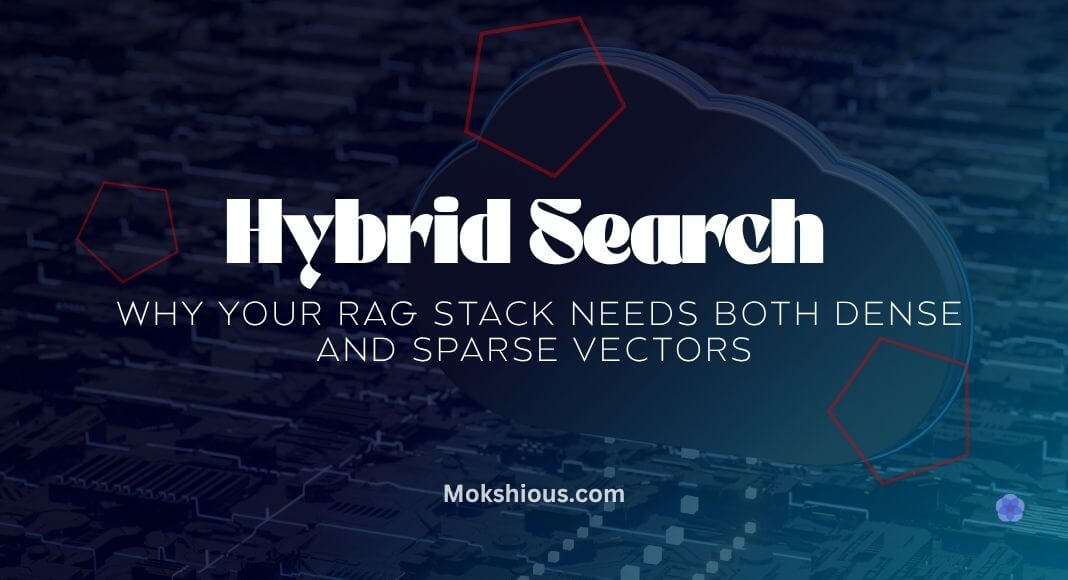If you’re running a RAG stack in production, relying on just dense or sparse vectors is like trying to search blindfolded. You’re either over-indexing on fuzzy intent or missing literal keyword matches that matter, especially for compliance-heavy domains like finance, legal, or healthcare.
Hybrid search fixes this. It combines the power of semantic search with the accuracy of keyword search by fusing dense and sparse vectors into a single retrieval pipeline.
Let’s break it all down: how it works, why it matters, and how to start using hybrid search without blowing up your current stack.
What Is Hybrid Search? A Simple Primer

Definition of Hybrid Search
Hybrid search is the practice of blending semantic understanding from dense vectors with literal keyword matching from sparse vectors. It’s like running two parallel engines, one that understands meaning and one that matches exact terms, then merging the results for better coverage.
For example, searching for “ISO compliance” might yield related documents like “certification standards” or “data security frameworks” using dense embeddings, while sparse vectors will catch exact keyword matches like “ISO 27001.”
| Search Method | Strength | Weakness |
| Dense Vectors | Great for intent and synonyms | May miss keyword-specific content |
| Sparse Vectors | Perfect for literal matches | Can’t group concepts or semantic equivalents |
| Hybrid Search | Merges the best of both worlds | Slightly higher compute or storage overhead |
Dense Vectors (Semantic Search)
Dense vector search uses embedding models to map language into a high-dimensional vector space. These embeddings capture meaning, not just words. When a user asks, “Show me retention policies,” the system can find documents that say “data lifecycle rules” without the exact phrase being present.
Tools like LangChain retriever help plug dense passage retrieval (DPR) vector search into modern RAG stacks, turning each query into a vector embedding.
Sparse Vectors (Keyword Search)
Sparse vectors are the classic full-text search workhorses. They rely on algorithms like BM25, TF-IDF, and newer models like SPLADE to score documents based on how often a term appears and how rare it is in the corpus.
Sparse search gives you precision. It hits exact keyword matches, making it essential for regulated industries where missing even one key term could be costly.
Why Combine Dense + Sparse? The Business Case

Better Recall & Precision
Dense vectors help you search by meaning. Sparse vectors help you match specific words. Hybrid search at scale, higher recall (you catch more relevant docs), and higher precision.
This makes a big difference in high-stakes enterprise settings where query accuracy, retrieval integrity, and search result relevance directly impact productivity and compliance.
Hybrid Search Cuts Infra Costs
Here’s where it really hits the bottom line.
- Smaller context windows → fewer tokens → cheaper LLM prompt costs
- Better recall → fewer re-prompts → lower API bills
- Improved relevance → faster answers → higher user satisfaction
Key cost drivers that hybrid search helps with:
- Number of DB hits per search request
- Length of the vector index
- Time spent crafting prompts for multiple retries
Governance, Brand Safety & Compliance
In industries where hybrid and keyword-based search is non-negotiable (think legal clauses, regulatory filings, or audit logs), sparse vectors catch exact matches.
Meanwhile, semantic search via dense embeddings helps surface meaning, like mapping “whistleblower” to “anonymous reports” or “incident escalation.”
Using hybrid retrieval means better search capabilities for oversight, audits, and brand trust.
How Hybrid Ranking Works (Reciprocal Rank Fusion)

What is Reciprocal Rank Fusion?
Reciprocal Rank Fusion (RRF) is the algorithm used to combine dense and sparse rankings. It takes two ranked lists and scores each document based on how well it performed in both.
RRF(d)=∑1/(k+rank(d,listi))RRF(d) = ∑ 1 / (k + rank(d, list_i))
So if a document ranks #2 in the dense list and #4 in the sparse list, it’ll likely rise to the top of the hybrid index. This gives hybrid search results a better balance between precision and context engineering.
Performance Considerations
Running two search pipelines might sound expensive, but optimized search algorithms and vector databases like Pinecone hybrid search or Weaviate have made this efficient.
- RRF fusion latency is often under 20ms
- Hybrid indexes with multiple vector fields allow you to balance speed and quality
- You can batch or cache search queries to save even more compute
Benefits of Hybrid Search in RAG Stacks

When you’re working with a Retrieval-Augmented Generation (RAG) stack in production, especially in an enterprise environment, the stakes are high. A missed document here or a hallucinated result there can mean hours of confusion or even a compliance red flag. This is where hybrid search steps in.
Let’s dig into the real-world benefits of hybrid search in a RAG stack:
1. Improved Recall and Precision, at the Same Time
Dense vectors are fantastic at understanding context and intent, but they sometimes miss exact matches. Sparse vectors (think keyword search with BM25 or SPLADE) catch literal phrases but can’t “think” abstractly.
Hybrid search combines both. That means:
- You’ll catch more relevant documents that a semantic-only search might miss.
- You’ll also avoid flooding the output with irrelevant results that dense-only retrieval sometimes throws in.
- Precision increases, especially for compliance queries and long-tail search terms.
For enterprise knowledge bases that support everything from legal documentation to internal policies, this balance is gold.
2. Fewer Hallucinations in LLM Output
Here’s a big one: hybrid search drastically cuts down hallucinations by anchoring LLMs with exact keyword matches.
Semantic retrieval might think “data storage” is good enough for a “retention policy” request, but legal wants the exact section title: “Retention Schedule 5.2.” Sparse vectors deliver that.
This gives the model more relevant chunks to work with during generation, which keeps the output more fact-based and reduces the need for re-prompting.
3. Smaller Prompts, Lower Token Usage
With hybrid retrieval, you’re feeding your model tighter, cleaner context windows, no fluff. That means:
- Less need for summarizing massive document chunks.
- Lower prompt size in tokens (which directly impacts LLM cost).
- Faster response time since the model has less to parse.
On average, hybrid search can reduce context window size by 30–50%, leading to a noticeable drop in monthly API bills.
4. Better Governance and Compliance
For teams under audit or in industries like finance and healthcare, this is a game-changer.
Sparse search ensures no critical keywords are missed. Dense vectors ensure the query is interpreted correctly. Together, they make your search pipeline more trustworthy and auditable.
You can tell your compliance team: “Yes, this bot always surfaces the literal language from our risk policy, even if the prompt is vague.”
Implementation: Adding Hybrid Search to Your RAG Stack

Weaviate Example (Hybrid Operator)
Weaviate supports hybrid retrieval out of the box. You can pass both dense vector and sparse vector signals using a simple JSON block.
{
“hybrid”: {
“query”: “ISO compliance”,
“alpha”: 0.7
}
}
Pinecone HybridSearchRetriever (LangChain)
LangChain has a built-in retriever that integrates with Pinecone to perform hybrid search using both vector and keyword search inputs.
This lets you fuse text search with semantic search for enterprise-grade retrieval.
Indexing Strategy
To implement hybrid search cleanly:
- Use SPLADE to generate sparse vectors
- Store both dense and sparse vectors in your vector database
- Perform a hybrid index lookup using RRF at runtime
- Blend results dynamically per search request
Open-Source Libraries That Support Hybrid Search
- Jina AI: Full-stack vector search orchestration
- Haystack: Plug-and-play retriever pipelines
- Qdrant: Blazing fast hybrid-compatible vector DB
- txtai: Lightweight and easy to embed in any project
Cost Optimization, ROI & KPI Benchmarks

TCO Model Inputs
To build a solid search system business case, track these inputs:
- KPIHybrid TargetDense-only Baseline
- Re-prompts/query < 1.2 2.3
- Precision@5 > 0.78 0.63
- Avg cost/query < $0.005 $0.015
- Search latency < 400ms ~850ms
- Prompt size (tokens) ~700 ~1600
ROI Scenario Example
In a SaaS support environment, adding a hybrid search:
- Reduced re-prompts by 38%
- Cut average cost per query by 66%
- Improved search precision and reduced escalations
- Saved ~$400K annually in compute, tickets, and dev overhead
Challenges and Considerations

Now, let’s be real. Hybrid search isn’t all smooth sailing. There are a few things to keep in mind before you flip the switch.
1. Performance and Latency Overhead
Running two retrieval methods and then merging results adds some computational overhead. If your infrastructure is already strained, this might be noticeable.
- Fusion via Reciprocal Rank Fusion (RRF) adds 10–30ms depending on scale.
- More documents might be fetched from the vector database, increasing bandwidth.
But with proper tuning (batching, parallel fetches), most setups keep total query latency under 400ms.
2. Storage and Index Size Grow
Storing both dense embeddings and sparse vector representations doubles your storage requirements.
- Sparse indexes (BM25, SPLADE) are generally lightweight.
- Dense vectors, especially at higher dimensions (768, 1536), can bloat your vector index fast.
You’ll want to monitor growth and possibly use compression methods like quantization or pruning.
3. Fusion Logic Needs Tuning
How you combine dense and sparse scores matters. If your reciprocal rank fusion weights are off, you might over-prioritize one side and lose the benefits of the hybrid altogether.
- Set alpha values (or weights) based on your query mix.
- Regularly evaluate search quality with test sets.
This requires collaboration between product, data science, and engineering teams. But once it’s tuned, it hums.
4. Tooling and Debugging Are Less Mature
Hybrid search is still evolving. If you’re expecting plug-and-play dashboards or turnkey analytics, be ready to do a bit more manual setup.
Not all retrievers (especially custom ones) support hybrid out of the box, so integration with pipelines like LangChain or Haystack may need glue code.
Best Practices and Tips

Want to get the most out of hybrid search in your RAG stack? Here are some battle-tested recommendations:
1. Start with a Focused Use Case
Don’t try to hybridize everything at once. Pick a high-ROI segment:
- Internal knowledge base for engineering teams
- Support documentation lookup
- Regulatory document search
Roll out gradually and monitor the improvements in query success rate and search result quality.
2. Set a Sensible Default Fusion Ratio
If you’re using RRF or alpha blending, don’t start with 50/50 unless your queries are balanced. For most teams, semantic queries dominate, so try:
- Dense weight: 0.7
- Sparse weight: 0.3
Then adjust based on logs and actual user behavior.
3. Log and Monitor Your Queries
Track which type of query is leading to what kind of retrieval:
- “Exact keyword match” vs “semantic similarity”
- What’s being shown vs. what’s clicked
- Where hallucinations or irrelevant results happen
Use this to fine-tune retriever settings and adjust index frequency.
4. Keep Your Indexes Fresh
Update dense and sparse vectors regularly, especially if:
- You publish or change a lot of documents
- Your LLM embedding model changes
- SPLADE/BM25 scores need recalibrating with new corpora
Fresh indexes = relevant results.
5. Test with Real Search Logs
Use real-world search logs to benchmark performance. Metrics to track:
- Precision@5 and Recall@10
- Avg cost/query
- Context window token count
- Re-prompt rate
Conclusion: Why Both Dense and Sparse are Essential for Modern RAG Solutions
If you’re only using dense or sparse search, you’re playing with half the deck.
Hybrid search enhances retrieval, reduces cost, improves the search experience, and unlocks compliance-ready, board-level precision.
With today’s tools, it’s easier than ever to implement hybrid search. Whether you’re scaling customer support bots, internal KBs, or enterprise chat interfaces, combining dense and sparse vectors is the way forward.
Now’s the time to level up your vector search work and get the search result quality your business and your users deserve.
